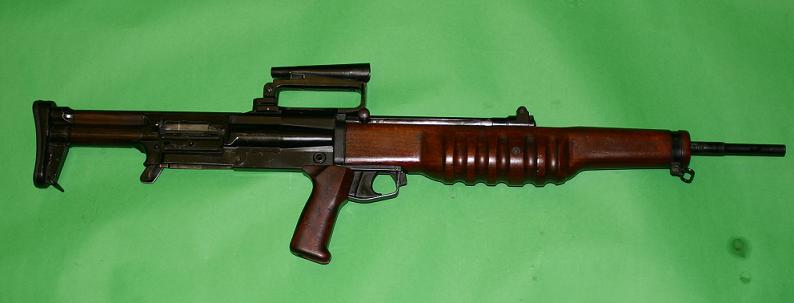The EM-2 was the result of a British research and development program looking for a replacement for the venerable Lee Enfield rifle after WWII. As with just about every other country on the planet, they were largely influenced by the German Sturmgewehr, and the program was built around the .280 Enfield cartridge. This was a good intermediate-power cartridge, firing a 140 grain bullet at about 2450fps – slightly more potent than the Soviet 7.62×39 and the “new” 6.8 Remington SPC.
 The EM-2 used a long-stroke gas piston mounted above the barrel, and a locking system similar to the Degtyarev series of machine guns. Two flaps were mounted in the bolt carrier, and would pivot out to engage locking recesses in the receiver when in battery. The system was a bit complex, but effective and well sealed against dirt and dust.
The EM-2 used a long-stroke gas piston mounted above the barrel, and a locking system similar to the Degtyarev series of machine guns. Two flaps were mounted in the bolt carrier, and would pivot out to engage locking recesses in the receiver when in battery. The system was a bit complex, but effective and well sealed against dirt and dust.
Disassembly was simple enough, as the buttplate could be rotated up and removed, allowing the recoil spring, piston, and bolt carrier to slide out the back of the receiver. The safety was located in the front of the trigger guard much like the M1/M14 rifles, and the magazines were of the “rock-n-lock” variety, with an AK-like latch at the back of the magwell. The optical sight was fixed; zeroing was done with screw adjustments on the front of the carry handle.
The EM-2 was chosen over the EM-1 rifle as an standard service rifle as the No9 Mk1 rifle in 1951. Before it could be put into serious production, though, the government decided to indulge the US and adopt the new 7.62×51 cartridge instead (thus paving the way for the L1A1 rifle). A few decades later they would return to the bullpup configuration with the L85 rifle (which bears no mechanical similarity to the EM2 except gross configuration).
We have photos of this particular EM-2 in pretty obsessive detail (there are a hundred total) for you to take a look at on the British EM-2 page in the Vault.

Influented by Felschjirmjaggergewehr FG42 not sturmgewehr….
I didn’t mean the mechanical design of the StG, but rather the tactical concept of a lighter round and rifle more suited to close range, high intensity combat instead of long range marksmanship.
Many thanks for posting about the EM series.
I’d always been curious about it’s innards. An article published in the ’80s (I think it was by Yearsley) claimed that the 60 or so EM2 prototypes had pretty consistent 1/2 MOA accuracy.
Whether the accuracy potential was intrinsic to the design, or due to the care with which the tool room had hand fitted the prototypes and loaded the trial batches of ammunition, I guess we’ll never know.
If the machinist’s blueprints are ever released, what a great little gun it would be in one of the Bench rest Remmington or PPC rounds.
p.s.
Have you ever looked at using one of the photogrammetry packages like “photomodeler” to derive accurate scaled CAD drawings from your photos?
If only Churchill had persisted with the EM2, light years ahead of its time.